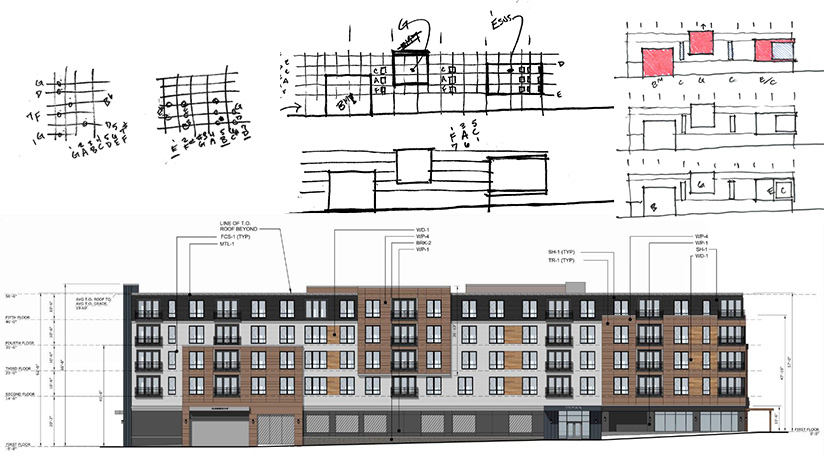When coworkers hear Aksel Solberg (AIA, NCARB) whistling at his desk, they might think he’s just in a good mood. But given the architect’s views on the connections between music, math and architecture, something a bit more mysterious could be going on.
“You can see how I shaded some of the masses and, under those, wrote what the chord is,” Aksel said recently, pointing to an elevation drawing of a mixed-use project slated for a New England town. “There is a B major chord, a G chord and an E chord with a C-dominant bass root.”

In deciding how to arrange different finishes and masses across the project’s exterior façades, Aksel envisioned these side-by-side buildings as a blank sheet of music paper, with staves for notation. He then began fitting different architectural elements into the elevation as though they were notes in a classical composition. Essentially, the fronts of these buildings became “blank measures” in physical space.
“I actually developed a melody for it,” he said. “What you see in the drawing here are the chord structures. They’re being played for a duration of time based on the intervals that I was able to create for the length of these buildings. The whole elevation is about five bars.”
Aksel, who leads HFA’s Development Design Studio in Franklin, Massachusetts, recalled hearing that mixed-use melody run through his head. “On that day in the office, I was whistling it.”
An architect’s life…on stage
Since beginning his architectural career in 2007, Aksel has worked on a wide array of projects, from office and industrial spaces, to schools, museums, houses of worship and renovations of historic buildings. But away from the drafting table, the New England native is a dedicated and highly trained musician.

Fans of the Boston music scene are accustomed to seeing Aksel up on stage with his cream-white electric guitar—a Paul Reed Smith Custom 24—at venues such as The Middle East Club and The Paradise. Aksel was still in high school when he joined the Boston and Cambridge music scenes as the bass player for punk and grunge bands like Point Zero and Tensions Run High. During his college years, he focused on folk and Americana and mastered the “Travis picking” guitar style made famous by Nashville legend Chet Atkins.
These days, Aksel routinely plays shows around New England in bands such as The Franklin Underground and the Gin Dogs. In the first group, he knocks out hard-edged, polyrhythmic funk riffs inspired by James Brown, Tower of Power, the Red Hot Chili Peppers and Incubus. In the second, Aksel plays country rock and classic blues alongside one of his main influences in music and life—his father, Andy.
Immersed in music
Growing up in Massachusetts, Aksel was immersed in music. His father, a professional musician, had earned a degree in music theory, composition and classical guitar in the 1970s. He continues to perform regularly on guitar, vocals, violin and bass, and also plays keys, drums, trumpet and pedal-steel guitar. Aksel’s paternal grandmother, who during World War II served in the Pacific Theater as part of the Red Cross, was a piano virtuoso. “Her performances at USO events were a regular occurrence,” he said. She went on to teach at the Manhattan School of Music from the 1950s until about 1980.

His mother Jackie also was a gifted pianist. The architect recalled her sitting with him at the piano and teaching him to read music from classical compositions. “She was always playing the piano and singing on weeknights during my childhood,” Aksel said. “Her enjoyment of the piano led me to pursue it further on my own.”
In his youth, Aksel was surrounded by instruments in a house perpetually filled with music. He was about three years old when he first tried to play his father’s guitar, which was comically oversized for him. “There are pictures of me as a toddler holding it,” he said. “The scale juxtaposition is very funny.”

The younger Solberg spent hours with his father playing and listening to everything from country hits by Willie Nelson and George Jones to jazz standards by Miles Davis, John Coltrane and Count Basie. Virtually any gathering of family and friends could morph into an impromptu jam session. “There was no getting away from music growing up,” Aksel said. “That’s for sure.”
Discovering architecture
Aksel had interests beyond music. He was obsessed with drawing and illustration, and fascinated by science and math. He turned to architectural studies after his father dissuaded him from going to music school. “His argument there, which ultimately convinced me, was that I had spent my whole life learning music theory, and I already knew how to read, compose and play,” Aksel recounted. “Music school would be teaching me things I already knew.”
In the course of earning degrees in architecture from Boston’s Wentworth Institute of Technology, Aksel discovered the interrelationships between math, architecture and music. He further explored these ideas in graduate school while living in Germany and visiting European opera houses and performance halls. “I realized that all of my most awe-inspiring experiences had happened in buildings that had been designed based on musical compositions and the forms and principles of acoustic engineering,” Aksel said. “I started to connect more of those dots.”
His master’s thesis centered on composing music, abstracting the underlying mathematics on a computer, and then using those formulae to create specific architectural forms. “Ever since, I have been looking to find opportunities to just throw a little bit of that musical influence into the design process,” Aksel said.
The mixed-use building in New England is the latest example. On another project—a plaza located in front of a music-education tenant space—the architect took inspiration from the string counts and proportions of a guitar fretboard, as well as chord shapes, to create a trellis design that cantilevered out over the plaza.

Cosmic truths
In Aksel’s view, the 12 notes of Western music can be seen as mathematical proportions in relationship with one another—a truth first expressed in ancient Greece. “The Pythagorean theorem was developed because of the relationship Pythagoras found between string lengths,” he said. “Math and ratios are everywhere in music—for example, in the time signature, whether you are playing in four-four, three-four or six-eight time.”
As part of his master’s thesis, Aksel did a deep dive into those harmonic relationships as well as their more cosmic connections to ancient mathematical concepts such as the golden ratio and the golden rectangle. He cites a famous diagram of a nautilus shell cast within a rectangle, with the shell curving around and spiraling out in an exponential curve factor. “Expressed mathematically, that curve factor is 1.618,” Aksel said. “You can find this repeated everywhere in nature, including in all of the chord harmonies that humans find pleasant.”
Harmonious sounds translate into parallel mathematical structures and—with a deft touch at the drafting table—aesthetically pleasing architectural forms. “I just find it all so fascinating,” Aksel said.
No wonder he sometimes whistles while he works.



.jpg)



.png)
.jpg)

.jpg)



